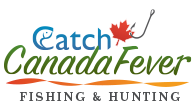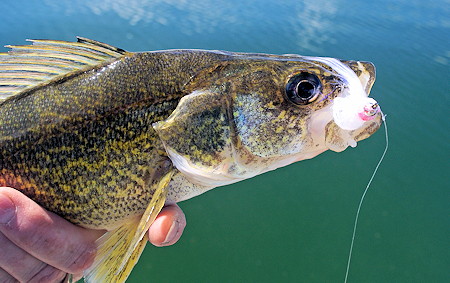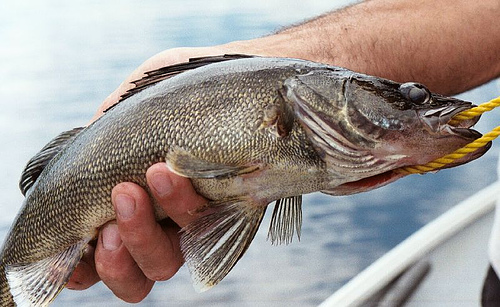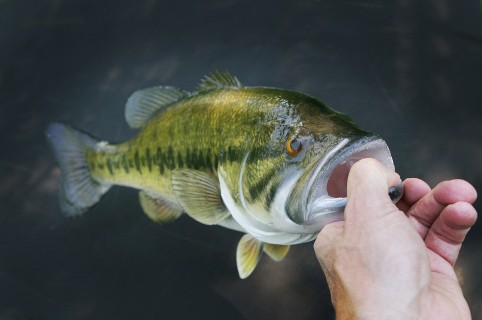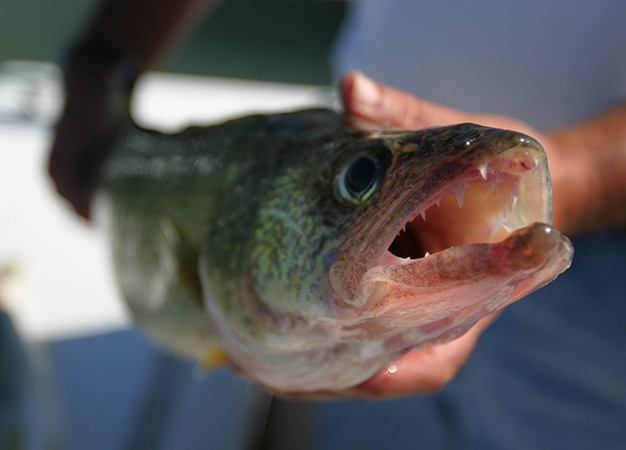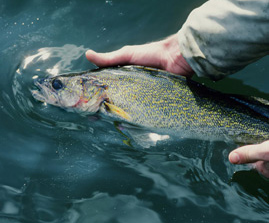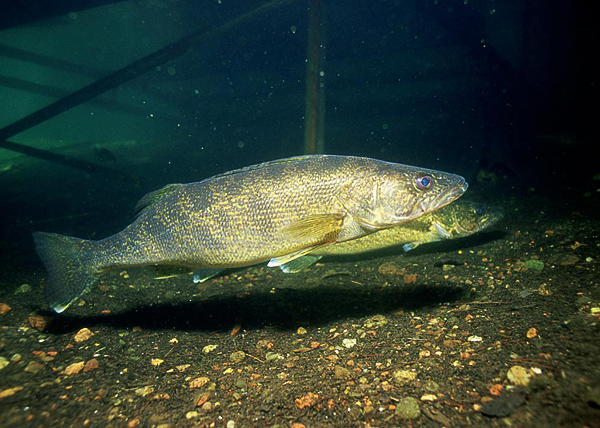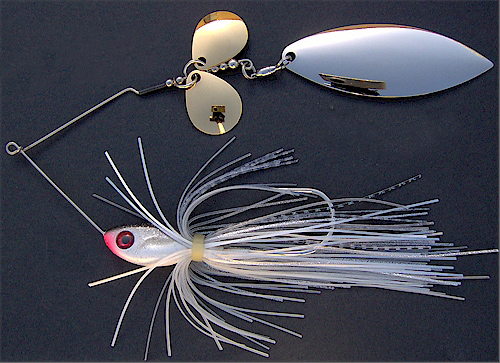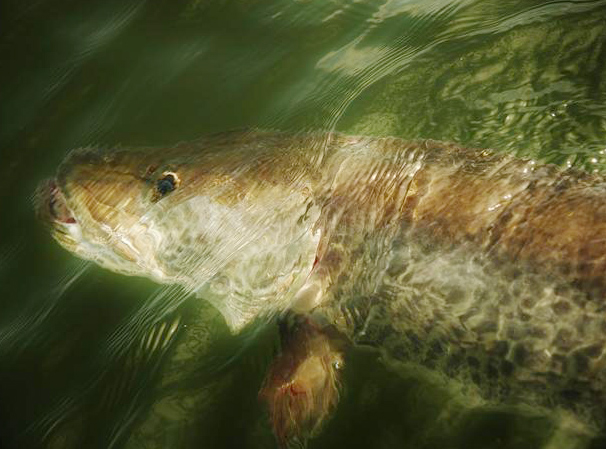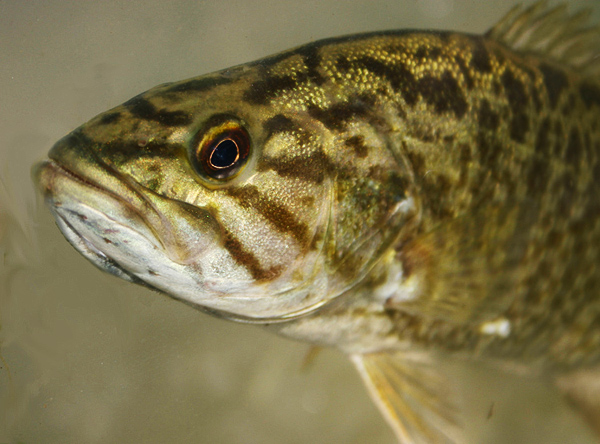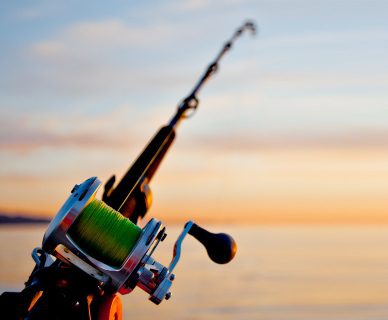Lake trout are predictable. The fork-tailed ones are shallow in spring, go deep in summer, and return to reefs come fall. The most predictable thing about them, however, is that no matter what the season or conditions, some are always near bottom, where they’re catchable. One of the best ways to hook them is with jumbo jigs. I consider any jig over 1 ounce to be a jumbo, and I’ve used them as large as 3 ounces. They’re beautiful in their simplicity. They get down to bottom quickly, are heavy enough to kick up a lot of mud, and can carry live or artificial baits as attractors.
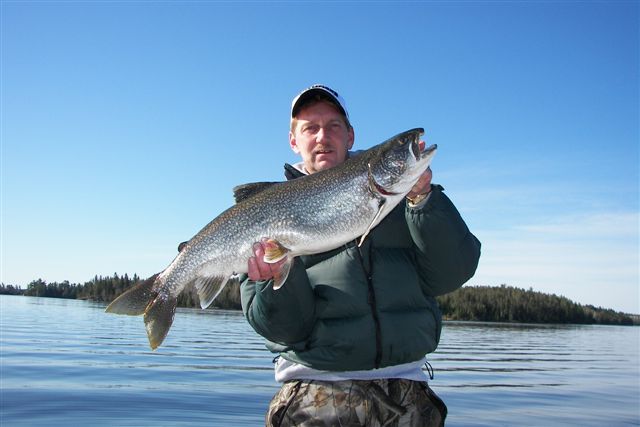 My introduction to their effect on lake trout occurred nearly 20 years ago on the western shore of Lake Superior. Dad and I were ice fishing and noticed that a group of Minnesota anglers was pounding lake trout in deep water. We went over to inspect and discovered that they were jigging big, white Northland orginal bucktail jigs sweetened with strips of sucker belly. Some of them were also pulling Airplane Jigs, winged things that spiral on the drop. The heap of fat lake trout around their holes was all the convincing we needed to stop hanging dead smelts and start jigging. Later, outfitted with dozens of jumbo jigs and several pounds of sucker, we got in on the action too. The next summer, I tried them in open water and they were even more effective. They’ve rarely failed me since.
My introduction to their effect on lake trout occurred nearly 20 years ago on the western shore of Lake Superior. Dad and I were ice fishing and noticed that a group of Minnesota anglers was pounding lake trout in deep water. We went over to inspect and discovered that they were jigging big, white Northland orginal bucktail jigs sweetened with strips of sucker belly. Some of them were also pulling Airplane Jigs, winged things that spiral on the drop. The heap of fat lake trout around their holes was all the convincing we needed to stop hanging dead smelts and start jigging. Later, outfitted with dozens of jumbo jigs and several pounds of sucker, we got in on the action too. The next summer, I tried them in open water and they were even more effective. They’ve rarely failed me since.
It doesn’t matter whether it’s Lake Temagami or Lake of the Woods. They might be right on the mud or cruising just a foot above it, but there will always be some trout on bottom. This is why wire-lining has remained a consistent technique to catch lakers in July and August. Finding trout, however, is the largest hurdle when jumbo jigging. It’s a vertical presentation, so you can’t troll around looking for fish. You have to pick potential spots before you drop a line.
In summer, most lake trout are in the deepest water. Finding a lake’s main basin is relatively easy if you have a hydrographic chart or a depth-finder. Your job is more difficult without them. Canoe-bound anglers in trout-rich areas like Quetico or Algonquin Provincial Parks often face this situation. Luckily, wilderness lakers are eager to bite and will grab a jig anywhere within snapping distance. You can actually do a little blind prospecting by dropping a jig into what you think is a deep hole and pulling for five minutes. If nothing happens, move a hundred yards or so and try again.
When using electronics to locate bottom-hugging lake trout, adjust the settings. If you have a liquid-crystal-display unit (LCD), use the zoom to get a more detailed look at bottom. I usually turn my machine to 4X, which allows me to see the bottom 15 feet (4.5 m) of a lake. I also shut off the fish-ID, so I can see any partial hooks, streaks, or lumps on bottom that could be lake trout. A fish-ID interprets signals for you, but can be inaccurate. Bubbles and weeds can become trout. On calm days, you should be able to see your jig descending on an LCD. Watch for changes in bottom reading or thick lines that could be trout approaching your jig.
Most of the trout you’ll catch with jumbo jigs will be on or near bottom, but you’ll also bump into suspended fish in or just beneath the thermocline, which forms when lakes stratify in summer on calm days. The upper layer of water (epilimnion) warms, while the lower layer (hypolimnion) remains cold. Between the two is the thermocline, a transition zone where conditions are often perfect for lakers. The water is cool and there’s zooplankton, which attracts baitfish. Lakers hover beneath large schools of cisco, shiners, and smelt, picking off stragglers. Look for hooks or dark marks just below bait that marks on your LCD. These feeding trout are aggressive and will usually hit a jig on the drop.
Jigs of an ounce or two with slightly banana-shaped heads are the mainstays. Airplane jigs are also good choices, but are more tiring to pull all day. Generally, big jigs come with a 2/0 or 3/0 hook, and some have a No. 4 treble stinger attached to the body with wire.
The jig-colour rule for lake trout is simple. Use anything as long as it’s white. The majority of a lake trout’s summer forage is some shade of white or silver. For added appeal, I tip white orginial bucktail jigs with a 4-inch white twister grub. Tube jigs and shad bodies are also good. You can use sucker meat or other real bait, but it’s not really necessary. Summer lakers will hammer a big jig with or without meat.
Jumbo-jigging tools are a medium-heavy-action 7-foot baitcasting rod and a large-capacity baitcasting reel loaded up with 17-pound-test monofilament. While I’m not a big fan of low-stretch braided super lines, jumbo jigging is a situation in which they shine. You might be fishing as deep as 100 feet (30 m), where mono’s stretch becomes substantial, affecting feel for a jig and hook-sets.
When you drop a jig to bottom, thumb the spool and carefully watch your line as it enters the water. If you see it twitch or coil on the surface, press your thumb on the spool and set the hook. It’s common for trout to intercept a jig on its way down. If the jig makes it, engage the reel and jig with long sweeps of the rod. There’s no need for finesse. If trout want the jig, they’ll get it.
Jumbo jigging takes lake trout all around the calendar. If you like catching lunkers on simple tackle, look no further than this classic presentation.

